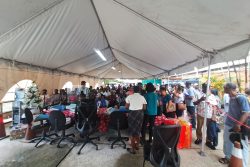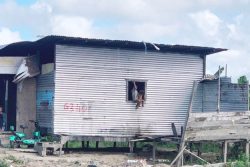Yesterday, September 7, should have been the first day back at school for the nation’s school-age children to commence the start of the Christmas Term. It transpires not just that schools remain closed but that the authorities have articulated no definitive way forward for classroom education delivery…at least not for the school term that is now with us.
Not only that; the vicissitudes of the coronavirus do not allow us to make any definitive call on a timeline for the resumption of in-school tuition, not now and not in the immediate future. To make matters worse, we are in possession of no alternative means by which to deliver education, across the board. What obtains are options that are rooted in information technology, for which, as households with school-age children, we are altogether inadequately equipped. Even if this were not the case, assuming that is, that the technological infrastructure was in place, across the board, and where homes, on the whole, were equipped with the tools with which to participate in the delivery and receipt of a virtual curriculum, our teachers, on the whole, are not adequately trained to deliver same. That too is a failing of the system.
If there has ever been a more formidable challenge, a more testing crisis in the history of our education system then we are unaware of it. We have, insofar as education is concerned, drifted into the realm of a worrisome ‘new normal’ where, at the very least, the universal delivery of education, across the social spectrum and in a manner that offers a condition that is at least roughly equivalent to equal access, is now, for the time being, at least, non-existent.
Such consequences as are likely to attend this circumstance are not at all likely to descend on us simultaneously. What threatens if the current state of play persists for much longer, is a sustained meltdown in what is left of our education system, a continual stripping away of what is left of the structure which (for what it is worth) nourishes the prevailing teaching/learning regimen. If this continues it will inevitably find its way into the arteries of our envisaged national development pursuits and derail those.
Almost two terms of a condition in which the shutters have been closed tight on the delivery of in-school tuition would have already had its profound consequences. One of those (perhaps the most important one) is that there has been no sustainable official option for keeping children anchored to the idea of structured learning. True, ingenuity and technology have provided some limited options, limited for the reason that there is no universal access to them, nor is such likely to be the case in the immediate future.
Of course, and as absurd as it might seem, there is, as well, the considerable likelihood that children who have been separated from structured learning and would have, presumably, been immersing themselves in both structured and unstructured options will, in many instances, even challenge the wisdom of returning to the classroom.
The situation will, of course, be more challenging for countries like Guyana where, traditionally, the quality of education available in the coastal and hinterland regions is qualitatively different and starkly so. If there may exist, in most coastal communities access to some technology-driven teaching/learning options, such options are absent in the vast majority of hinterland communities and this, needless to say, will, in the immediate future, and down the road, further widen the gaps in the quality of life in the respective geographic areas of the country.
Sober analysis of what obtains does not allow for an erratic apportioning of blame. The reality of the situation is that the ‘grand entrance’ of the COVID-19 has left the international community spellbound and much of it, muscle bound as well. That is not to say however, that the sloth and the sluggishness with which we in Guyana have sought to grow the capabilities of our education system have not been a factor that limits our options at this time. Truth be told, setting aside the admittedly resource-related challenges that we have had to contend with, there continues to be no seriously impactful effort, beyond what has been the mostly empty rhetoric of political promises, to significantly upgrade the capabilities of our education system; (perhaps we can begin by introducing Information Technology as a compulsory discipline at the CPCE.) The absence of upgrading applies across the board, from the evolution of the curriculum to the sufficiently adequate accumulation of either the technological or intellectual resources to bring about the incremental enhancement of the system as a whole.
One thing that has become perfectly clear, over the years, is that it has been the ambition of children and the sacrifices of parents, much more than the effort of the state, that has been responsible for the manifestations of intellectual excellence that have from our school system. The emergence of the contemporary private school system in Guyana, for example, has derived from an awareness on the part of investors in the sector, that ambitious parents and children striving for excellence were demanding more than the state school system was offering and that the state was reflecting an indifference to those demands. It was the continual meltdown in the quality of the state-provided primary and secondary education system that spawned the private school system though that is not to say that the talented and the disciplined in the state school system did not ‘come through,’ with the help of the other education-related growth industry, after-school lessons.
All sorts of imponderables lie ahead. Given what, at this stage, is the complete absence of predictability regarding the likely behaviour of COVID-19, going forward, no clear and coherent plan, particularly, no time frame, can be clearly articulated for a return to the classroom. We cannot plot a course for the future and leave the crest to an auto pilot arrangement. COVID-19 has already provided us with fearsome demonstrations of its ability to extract reprisals for our attempts to second-guess its behaviour.
There is simply no risk-free way that we know of through which the familiar system of education delivery can be restored at this time. Further, what now appears to be the option of pressing media, the electronic media, particularly, into service, to try to fill the gap created by the social distancing constraints which, at least for now, have flattened the classroom regime are really far from being even remotely adequate for all sorts of reasons. The coronavirus may not have been of our doing but our failure, over the years to continually and meaningfully upgrade our education system has meant that we have few (if any) even remotely effective weapons with which to fight the pandemic’s attack on the system.





